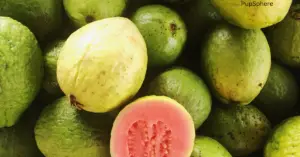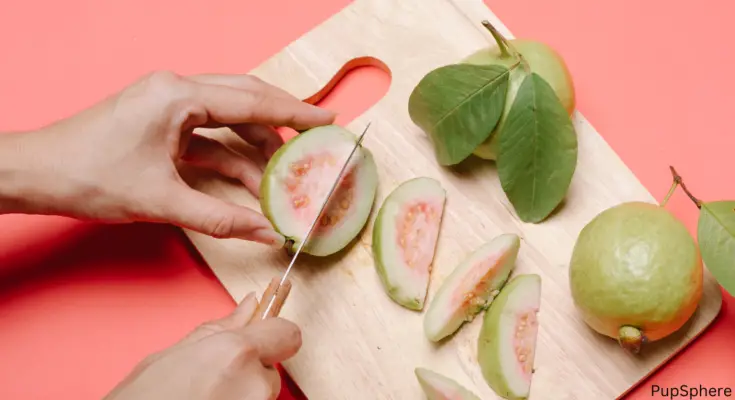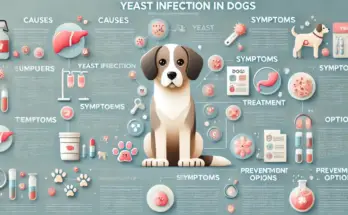Have you ever wondered if your dog can enjoy a guava as much as you do? If you’re considering sharing this juicy fruit with your furry friend, you’re in the right place! This guide breaks down everything you need to know about guava for dogs—its safety, health benefits, potential risks, and more. Let’s explore whether guava for dogs is a good treat for your pup!
What Exactly Is Guava?
Let’s start with the basics—what exactly is guava? It’s a tropical fruit from the myrtle family that grows on trees. Guavas usually have green skin with sweet pink flesh inside, but they come in a variety of types, each with its unique look and flavor.

Is Guava Safe for Your Dog?
Before introducing any new food to your dog’s diet, it’s always a good idea to consult with your vet. Some foods may not be suitable for every dog, especially those with specific health conditions.
While dogs don’t need fruit in their diet, many can enjoy guava for dogs as an occasional treat. Fruits like guava for dogs can be a fun and healthy supplement to their regular commercial meals. Just remember, moderation is key. Too much fruit can upset your dog’s stomach or cause weight gain due to the natural sugars found in fruits.
When feeding your dog guava for dogs, always remove the rind and seeds first. The rind is tough to digest and could be a choking hazard, while the seeds contain small amounts of cyanide, which can be harmful in large quantities. Make sure to cut the guava for dogs into small, bite-sized pieces to prevent choking.
Fresh guava for dogs is fine in moderation, but guava paste or guava used in baked goods and sweets is not recommended. These products are too sugary and can lead to digestive issues like vomiting and diarrhea. Guava for dog tea should also be avoided for the same reason.
Which Parts of Guava Are Safe for Your Dog to Eat?
When it comes to guava for dogs, the flesh is the only part that’s safe for your dog to eat. There’s a bit of debate around whether guava seeds are safe. While some might say they’re okay, it’s best to avoid them. Fruit seeds often contain small amounts of cyanide, which can be harmful to dogs if consumed in large quantities.
As for the skin, some sources say it’s fine, while others warn against it. The main concern is that the skin may be hard for dogs to digest, so it’s safer to skip it.
Guava leaves are another area of confusion. While some people claim guava leaves can be helpful for digestion, others suggest they can upset your dog’s stomach. Since there’s a chance the leaves could cause digestive issues, it’s better to avoid them as well.
In short, stick to feeding your dog the flesh of the guava for dogs and steer clear of the skin, seeds, leaves, and buds to keep your dog safe and healthy.
Which Varieties of Guava Are Safe for Your Dog?
There are several types of guava for dogs, and fortunately, they’re all safe for your dog to enjoy in moderation:
- Apple Guava: This common guava variety looks like a pear and is a popular choice.
- Pineapple Guava: With a green oval shape and a pineapple-mint flavor, this type has yellowish flesh.
- White Guava: Similar to a green apple or pear, this variety has creamy, white flesh and a sweet taste.
- Red Guava: Known for its green rind and pink flesh, this one is visually striking.
- Thai Guava: This type can have bumpy or smooth green skin with white flesh.
You can safely give your dog fresh or dried guava for dogs from any of these types. However, guava paste is a different story. It’s packed with sugar, which is not good for your dog’s health and can cause digestive problems. The same goes for sweetened guava for dogs yogurt. Even unsweetened yogurt may not be the best choice for your dog due to potential lactose issues.
Stick to fresh guava for dogs and avoid the sugary versions to keep your dog healthy and happy!

Health Benefits of Guava for Your Dog
Guava for dogs offers a range of health benefits, thanks to its rich nutrient profile. It’s packed with essential vitamins like vitamin A, along with vitamins K and B. Guava also provides important minerals like calcium and potassium, which support your dog’s overall health. The dietary fiber in guava for dogs helps promote a healthy digestive system, keeping things running smoothly. Plus, guava for dogs is loaded with antioxidants, which can help strengthen your dog’s immune system and keep them feeling their best.
How Much Guava Can Your Dog Eat?
When it comes to treats, they should make up no more than 10% of your dog’s daily calorie intake. But does that mean 10% of their daily food can be guava for dogs? Not exactly.
Why? First, too much fiber can be tough on your dog’s stomach. Also, guava for dogs has a fair amount of sugar, and too much sugar isn’t good for your dog’s health. If you give your dog too much guava, it can turn into an unhealthy treat rather than a beneficial one.
So, how much guava for dogs is okay? A few small pieces a couple of times a week is plenty. Keeping it in moderation will ensure guava for dogs remains a healthy and enjoyable treat for your dog.
More Dog-Friendly Fruits to Try
If you’re looking to treat your dog to some fruit, it’s important to know which ones are safe and which ones to avoid. Here’s a list of dog-friendly fruits that are often found in dog food ingredients too!
Just remember, always cut the fruit into small, manageable pieces, and be sure to remove seeds, rinds, pits, and leaves, as these can be harmful to your dog. Some parts of fruit may pose choking hazards or cause digestive issues.
Safe fruits for dogs include:
- Guava for dogs
- Apples (seeds removed)
- Peaches (pit removed)
- Cranberries
- Blueberries
- Mangoes (pit removed)
- Raspberries
- Strawberries
- Cantaloupe
- Cucumber
- Bananas
- Pears
- Watermelon
- Pineapple
- Honeydew
These fruits can make healthy, tasty treats for your dog when fed in moderation!

Toxic Fruits for Dogs to Avoid
Not all fruits are safe for dogs, as some contain toxins that can cause stomach issues or even more serious health problems. In some cases, consuming certain fruits can lead to conditions like kidney failure.
If your dog happens to eat any of the following fruits, contact your vet immediately:
- Grapes
- Raisins
- Wild berries
- Tamarind
It’s always better to be safe and monitor your dog closely when offering new foods!
How to Safely Feed Guava to Your Dog
Wondering how to safely feed your dog guava for dogs? Here’s a simple step-by-step guide:
- Remove the rind: It’s a good idea to peel the guava for dogs, especially the first time you offer it to your dog. If you want to try feeding the rind, give your dog just a tiny bit to start and watch for any reactions.
- Remove the seeds: Always take out the guava dog seeds before feeding your dog, as they can be harmful.
- Cut into small pieces: Slice the guava for dogs into small, bite-sized pieces to make it easy for your dog to eat.
- Enjoy the rest: Now you can enjoy the rest of the guava for dogs yourself!
When giving guava to dogs for the first time, offer just one small piece. If your dog likes it and doesn’t have any negative reactions, you can gradually give a little more in the future. Keep it in moderation for a healthy treat!

Did You Give Your Dog Too Much Guava?
If your dog usually handles guava for dogs well but starts showing signs of digestive discomfort, you might have given too much. Overfeeding fruit can cause issues like cramping, bloating, or loose stools. Keep an eye on your dog and cut back if you notice these symptoms!
Can Dogs Be Allergic to Guava?
It’s important to start with just a small piece of guava for dogs because some dogs can be allergic to it.
While guava for dogs allergies are common in humans, they’re less well-known in dogs. Still, your dog can have an allergic reaction. After offering guava to dogs for the first time, keep an eye out for any signs of an allergy.
How can you tell if your dog is allergic? Look for symptoms like hives, itching, paw or ear infections, facial swelling, or digestive issues.
If none of these symptoms appear, your dog can likely enjoy guava for dogs without any allergic reactions!
Fruits You Should Be Cautious About for Your Dog
Cherries
While the flesh of cherries isn’t toxic to dogs, the pits stems, and leaves contain cyanide, which can be harmful. Cherries are small, so it can be a bit tricky to remove all the pits, but if you’re careful, it’s fine to give your dog a few cherries as long as they’re pit, stem, and leaf-free. Just be cautious and make sure to remove any potentially dangerous parts!
Avocados
The pit, leaves, bark, and skin of avocados contain persin, a toxin that can be harmful to dogs. If your dog eats enough of these parts, they could get sick. While the avocado flesh/pulp does contain persin, it has much less than the other parts. However, the large pit poses a choking risk, and the avocado pulp is also high in fat, which can upset your dog’s stomach or lead to weight gain if eaten in excess. Always be cautious when feeding your dog avocado!
Tomatoes
Fully ripe tomatoes are safe for dogs to eat, but the tomato plant itself is toxic due to a substance called tomatine. Make sure your dog doesn’t eat any tomato plant leaves, stems, or unripe, green tomatoes. Only feed your dog ripe, red tomatoes, and always do so in moderation to avoid any potential issues.
Conclusion
Let’s recap what we’ve learned about guava and dogs.
Guava comes in various varieties, and all of them are safe for dogs to enjoy. This nutrient-packed fruit offers a great source of fiber, vitamins, and minerals that can benefit your dog’s health.
However, since guavas are high in sugar, they should only be given in small amounts to dogs.
So go ahead and share a piece of guava with your dog, but remember to keep it moderate. In small portions, this tropical fruit can be a tasty and healthy treat for your pet!”




